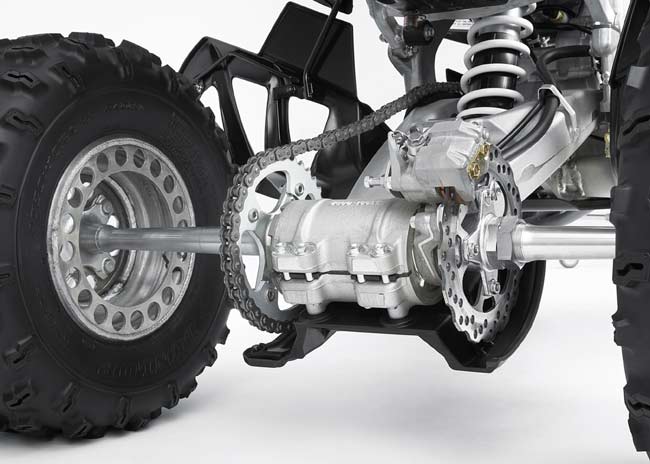4 Steps to Fix Race Sag

Four Simple Steps; No More Excuses
You hear it all the time- to get the most performance out of your quad, you need to properly set your sag. But it’s a task easier said than done. In most facets of society (the human body especially), sag is not a good thing. However, in the world of suspension this little measurement can make all the difference in the world. The good news is it’s nothing to be afraid of. In this article we’ll go through and step by step it so that you’ll be plum out of excuses as to why you’ve considered putting it off a moment longer.
Step 1: Establish Your Base
The first step is really the easiest step. The most difficult part is finding something on which to hoist your quad’s frame so that the rear wheels are off the ground. A true stand is the best way to go, but if you don’t have one an upside-down 5-gallon bucket should suffice. In a pinch we’ve seen riders use an automotive car jack but that should be your last option when all else fails.
Once the back wheels are suspended, grab a tape measure and measure from the very tip of the rear plastic right down to the center of the rear axle. Don’t be afraid to lean the tape slightly outward as your swingarm does not move directly up and down but rather curves in an arc when the shock is compressed.
Write this number down as it represents your base.
Step 2: Establish Your Race Sag
Take your ATV off the stand, bucket or jack and plop yourself down in the saddle. Have a friend take the measurement again (from the back of the plastic to the axle) while you are seated on the machine. Obviously since some shock compression will be taking place, this number will be less than your base measurement. Subtract it from the base and you just established your quad’s race sag. We told you this was easy!
Step 3: So Now What
So now you have your race sag number (which represents millimeters) on a piece of paper- what good does that do you? The answer is that you now know how close or far off the mark you are when compared to the optimal setup. Your owner’s manual should have recommendations as to the proper sag setup. If you don’t have your manual or it doesn’t specify, hit the internet and google your year, make and model followed by the words “race sag”. There are dozens of sites that will have specifics for just about every quad made.
Once you find out where you should be, it’s time to go back out to the workshop and make the numbers match. You do this by turning the preload ring on your shock. Rotating the ring clockwise will stiffen up the spring pressure (one full rotation usually equals around 3mm of sag) and simultaneously decrease the race sag number. Obviously going the other way has the opposite effect on both factors.
Step 4: StaticCling
Technically you’re good to go at this point, but there is one more measurement you may want to snag while you’ve got the tape measure and your piece of paper handy. After you’ve set your race sag, you are in a position to determine your quad’s static sag or the amount of compression taking place simply by the machine’s own weight.
To do this, simply roll your quad to level-ground (a paved driveway works really well for this) and measure from the rear of the plastic once more to the center of the axle. Take this number and subtract it from that first measurement you took (the base) and this is your static sag.
The reason static sag isn’t quite as important as the other measurements is that it’s main function is to assist in determining whether or not the spring you are currently running is adequate for your weight.
This is another figure you’ll find readily (typically in the manual) that can easily identify a potential snafu in your quad’s setup.
So there you have it, four simple steps and a few minutes labor in exchange for the peace of mind (not to mention performance benefits) of making the most of your ATV’s suspension.
